Optically tunable random lasing from azo-dye-doped polymer dispersed liquid crystal in capillary tubes
2019-11-11WANGDongshuoCHENMaozhouDAIHaitaoLUODanZHANGXiaodongLIUChanglong
WANG Dong-shuo, CHEN Mao-zhou, DAI Hai-tao*, LUO Dan, ZHANG Xiao-dong, LIU Chang-long
(1. School of Science, Tianjin University, Tianjin 300072, China;2. Department of Electrical & Electronic Engineering, Southern University of Science and Technology, Shenzhen 518055, China)
Abstract: This study demonstrated the optically tunable random lasing from azo-dye-doped polymer dispersed liquid crystal (PDLC) in capillary tubes, in order to expand new applications for this device. The azo-dye-doped PDLC was prepared in glass capillaries with different core diameters, and the random lasing thresholds of these samples were measured respectively. The spectra of random lasers were measured with increasing the intensity of ultraviolet radiation. The experimental results show that the random laser threshold measurements of different core diameter capillary samples (100 μm, 300 μm, 500 μm) are 11.8 μJ/pulse, 8.6 μJ/pulse and 13.2 μJ/pulse. The experimental results also show that as the intensity of ultraviolet radiation increases (from 0 mW/cm2 to 150 mW/cm2), the random laser intensity decreases gradually, and the FWHM of the spectrum becomes wider. And the random lasing showed similar properties under the UV beam with different polarized directions during the optical tuning process. Our work verifies the possibility to fabricate miniature laser devices in cylindrical confinement structures, and extends the application scope of PDLC.
Key words: laser and laser optics; dye lasers; liquid crystals; multiple scattering
1 Introduction
Random lasing devices have attracted substantial interests due to the unique properties, such as low cost and simple fabrication process[1-2], which have developed a variety of applications in photonic areas[3-5], bio-medicine[6-8], and imaging display[9]. Up to now, random lasing has been researched in different disordered materials, such as biological tissues[6-7], semiconductor powders[10-11], polymers[12-13], liquid crystals (LC)[14-15]and LC-based composite materials[16]. Among these materials, LC and LC-based composite materials, especially polymer-dispersed liquid crystal (PDLC), have been widely applied to the tunable laser devices due to their tunable properties.
In present studies, the random lasing emission based on LC-based composite materials has always been widely researched in the one dimensional confinement planar cell[14-16], which may limit practical applications of these devices due to the rectangular structure. As we known, two-dimensional (2D) cylindrical geometry, such as photonic crystal fibers (PCF), or capillary cubes, can minimize the lasing configuration, which is conducive to combine with other photonic or detective applications. Recently, holographic polymer dispersed liquid crystal (H-PDLC) Bragg gratings have been integrated in the solid core PCF[17]and glass capillaries[18]. Lin et al. have investigated the resonance characteristics of random lasers from dye-doped nematic liquid crystals[19]and PDLC[20]in capillary tubes.
Lasing properties based on dye-doped LC and PDLC can be tuned by different external stimuli methods, such as heating[21-22], electric field[23-24], and light irradiation[25], which is due to the change of LC refractive index induced by the reorientation of LC molecules. For example, Luo et al. have investigated temperature tunable properties of lasing from a dye-doped 2D H-PDLC photonic crystal[22]. Ye et al. have reported the electrically and magnetically controllable random lasing based on dye-doped LC[24]. However, the LC or PDLC can not be tuned easily by electric stimuli in capillaries because of the issues of depositing electrodes on inner surface of 2D structures. Also, the elevated temperature cannot be measured accurately and even degrade the physical properties of LC. Therefore, the light irradiation is regarded as a suitable method to achieve optically tunable random lasing in capillary tubes. The optical tunability of random laser is mainly attributed to nematic to isotropic (N-I) phase transition in LC droplets induced by trans-to cis-isomerization of azo dyes. As the cylindrical tubes can be irradiated by UV beam along different directions in two-dimensional plane, random lasing properties from azo-dye-doped LC and PDLC within capillaries can be tuned more effectively.
In this study, we investigated the opticallytunable random lasing from azo-dye-doped PDLC in capillary tubes with various core diameters. The random lasing properties from these samples were tuned with polarized UV irradiation. Experimental results indicated that the random lasing intensities from azo-dye-doped PDLC decreased as UV beam intensities increased. However, the random lasing emission was polarized independent, which was insensitive to the polarized directions of UV light. Furthermore, we excluded the temperature effects of UV beam and pump laser in the experiment.
2 Experiment
The azo-dye-doped PDLC syrup was prepared at first, including 79.5%(mass fraction)nematic LC E7 (no= 1.521,ne= 1.746, Hecheng Display Technology), 20%(mass fraction)monomer norland optical adhesive 65 (NOA65), 0.25%(mass fraction)laser dye Pyrromethene 597 (PM-597, Aldrich), 0.25%(mass fraction)azo dye Methyl Red (MR, Aldrich). The syrup was uniformly mixed and filled into untreated capillary tubes (Polymicro Technologies) with different core diameters (100 μm, and 300 μm, 500 μm) in dark condition, and the capillaries were sealed by optical glue. Finally, the capillary samples were exposed to UV light (20 mW/cm2) for two minutes to polymerize the monomer. After curing, the LC droplets were formed in polymer matrix randomly, there was no preferred direction.
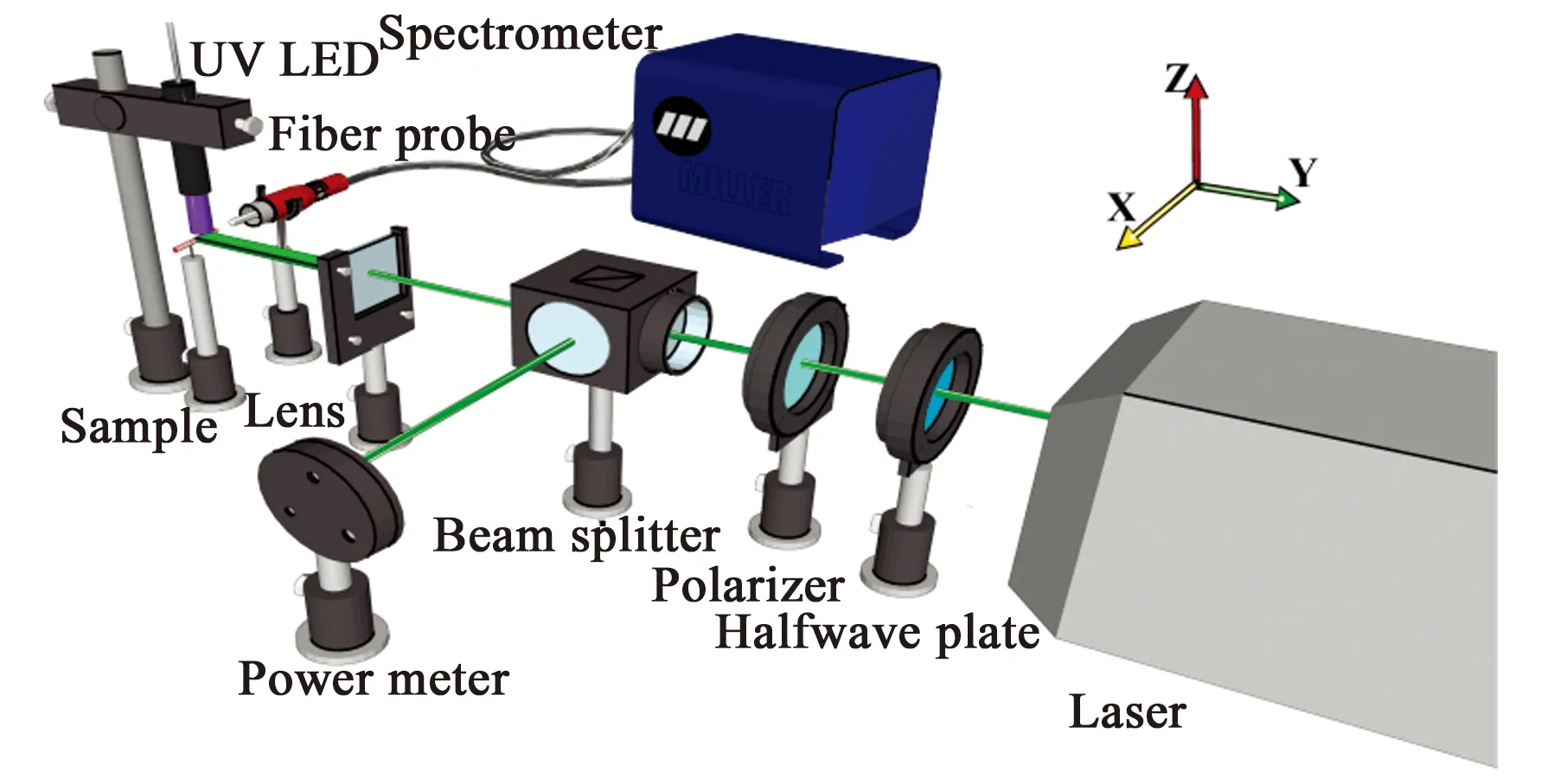
Fig.1 Experimental setup for optical tuning experiment to random lasing from azo-dye-doped PDLC
As shown in Fig. 1, the azo-dye-doped PDLC samples were excited by a Q-switched frequency doubled Nd∶YAG pulse laser at 532 nm (repetition rate∶10 Hz, pulse width∶5.32 ns). In front of the pump laser, a half-wave plate and a polarizer were used to vary the pump energy for random lasing emission. Then, the incident pump beam was divided into two parts by the polarizing beam splitter. The smaller beam was measured by a power meter, and the other beam was focused on the capillary samples by a cylindrical lens (focal distance: 20 cm) to ensure sufficient pump energy for random lasing emission. During the optical tuning process, capillary samples were pre-illuminated by UV beam at 365 nm (UVPL-4, Yunhoe) with different intensities for a fixed time (20 s). The lasing spectra along the capillary direction were recorded by an optical spectrometer (Avantes, resolution: 0.3 nm).

Fig.2 Evolution of random lasing spectra from azo-dye-doped PDLC with different pump energy in (a) 100 μm, (c) 300 μm, and (e) 500 μm capillaries; corresponding peak intensities and FWHM of the emission spectra from capillary samples with core diameter of (b) 100 μm, (d) 300 μm, and (f) 500 μm.
3 Results and Discussions
The random lasing thresholds from azo-dye-doped PDLC (S I) were measured at first, in order to determine suitable pump energy for the optical tuning experiments. Fig. 2(a), 2(c) and 2(e) illustrate the emission spectra evolution with increasing pump energy in different core diameter capillary samples (100 μm, 300 μm, 500 μm), and the insert maps reveal the random lasing patterns of capillaries. Fig. 2(b), 2(d) and 2(f) summarize the lasing peak intensities and corresponding full widths of the half maximum (FWHM). The intensities of fluorescence spectra from capillary samples increased gradually under low pump energy. As the pump energy exceeded the lasing threshold, the FWHM of spectra narrowed dramatically, and meantime some random lasing peaks began to emerge on the top of fluorescence emission spectra. The random lasing thresholds in different core diameter capillary samples (100 μm, and 300 μm, 500 μm) have be measured as 11.8 μJ/pulse, 8.6 μJ/pulse and 13.2 μJ/pulse, respectively [Fig. 2(b), 2(d) and 2(f)].
To investigate the influence of azo-dye (MR) on random lasing spectra, we measured the random lasing spectra and obtained the threshold of dye-doped PDLC (DDPDLC) without doping MR (S П) in 300 μm capillaries [Fig.3(a)]. The threshold of S П is about 4.4 μJ/pulse, which is lower than that of S I. To ascertain this result, we measured the absorption and photoluminescence (PL) spectra of PM597 and PM597 added in MR solutions. After doping MR, as shown in Fig. 3(b), the absorption spectra increased and the PL spectra decayed, which can indicate that MR has a negative influence on the fluorescence and lasing thresholds. Since azo-dye (MR) will cause fluorescence loss, we doped a small amount of MR (0.25%) into the DDPDLC in our experiments.

Fig.3 (a) Random lasing evolution of DDPDLC without doping MR in 300 μm capillary; (b) Absorption and PL spectra of PM597 and PM597 doped with MR solutions.

Fig.4 (a)~(c) Evolution of the random lasing based on azo-dye-doped PDLC in 100 μm, 300 μm, and 500 μm capillary samples and (d) DDPDLC without doping azo-dye in 300 μm capillary sample, as the samples were irradiated by UV beam with various intensities from 0 mW/cm2 to 150 mW/cm2 and a fixed irradiation time of 20 s.
The optically tunable random lasing from azo-dye-doped PDLC was investigated according to the experimental setup in Fig.1. In order to ensure sufficient energy for random lasing emission, the pump energy was fixed at 25 μJ/pulse, which was higher than the lasing thresholds. The S I was pre-irradiated by UV beam with various intensities from 0 mW/cm2to 150 mW/cm2and a fixed irradiation time of 20 s. Fig.4(a)~(c) illustrate the random lasing evolution from S I with 100 μm, 300 μm, and 500 μm core diameters in the optical tuning process. As UV irradiation intensities increased, the random lasing intensities tended to decay, while the FWHM of the whole spectra became wider gradually. To compare with the results of S I, we conducted the optical tuning experiments on S П (without doping MR) with 300 μm core diameter [Fig.4(d)]. The random lasing properties of S П varied slightly after UV beam irradiation, which can demonstrate that the azo-dye (MR) played an essential role during the experiment.
The optically tunable effect is mainly attributed to the refractive index change of azo-dye-doped PDLC induced by the trans-to cis-isomerization of MR. Before UV beam irradiation, as shown in Fig.5, the MR molecules tend to be trans-state, which can be aligned by LC molecules through the guest-host effect in capillaries. Since the azo-dye MR has an absorption band in the UV range [Fig. 3(a)], some MR molecules with trans-state will convert into cis-state after irradiating by UV light. This effect will disturb the order of LC molecules in the LC droplets, causing the LC phase transition from nematic to isotropic (N-I) phase transition. The nematic and isotropic refractive indices of LC droplets (nNandnI) can be estimated as the following experiential formula[26]:
(1)
(2)
As for LC E7 used in the experiment, the values ofnNandnIare 1.64 and 1.60, respectively, and the polymer refractive index (np) is 1.524. Therefore, the N-I phase transition in the experimental process can decrease the refractive indices difference between the polymer and LC droplets. Because this change can increase the diffusion constant, the scattering strength of photons in capillary samples can decrease[27], which has some negative influence on photon localization for random lasing emission. As UV irradiation intensities continued to rise, the concentration of MR molecules with cis-state increased, leading to the further decay of random lasing intensities.
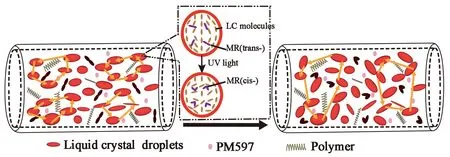
Fig.5 Mechanism for LC phase transition from nematic to isotropic and the multiple recurrent light scattering in the capillary samples induced by the trans-to cis-isomerization under UV beam
Furthermore, since azo-dye is sensitive to the polarization of light[28-29], we investigated the effect of UV beam with different linear polarized directions on random lasing properties. At first, the S I syrup was filled into the 300 μm capillaries in dark condition, and the capillaries were cured by UV beam (30 mW/cm2) with linear polarization along thex(y) axis (Fig. 1) to fabricate PDLC samples. Then, the capillary samples were pre-irradiated by UV beam with linear polarization alongxandyaxis, in order to compare the optical tunability of different polarized UV beam. The UV irradiation time increased from 0 s to 60 s, coupled with a fixed irradiation intensity of 50 mW/cm2. As shown in Fig.6(a), (b) [Fig. 6(c), (d)], the random lasing spectra decayed gradually at the similar extent during the same irradiation time, although the polarization of UV beam is different.
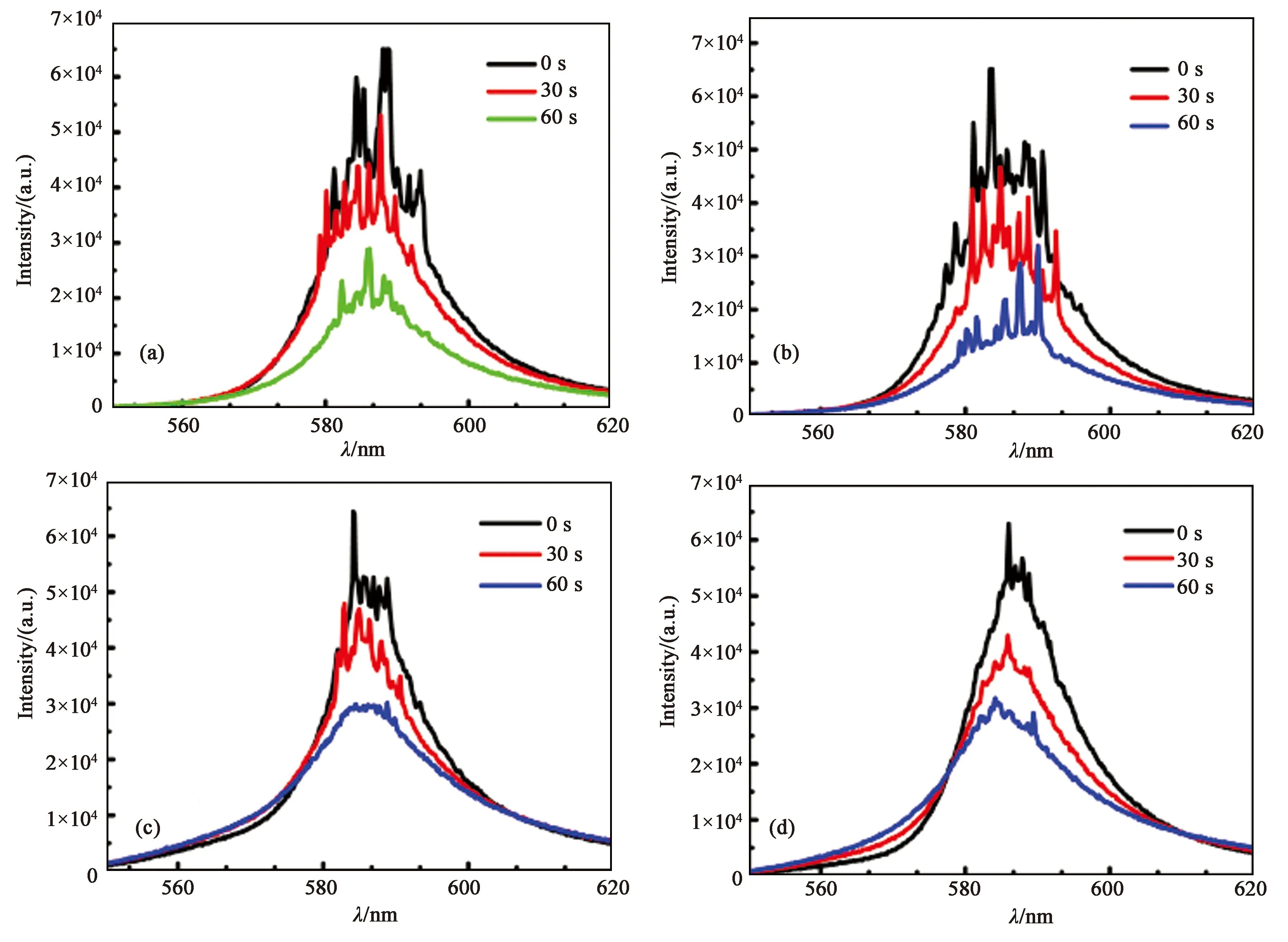
Fig.6 (a) and (b) ((c) and (d)) Evolution of the random lasing spectra based on azo-dye-doped PDLC in 300 μm capillary samples solidified by x (y) axis linear polarized UV beam and tuned by x and y axis linear polarized UV beam. In the experiment, the UV irradiation intensity was fixed at 50 mW/cm2, and the irradiation time increased from 0 s to 60 s.
The results indicate that azo-dye MR may have the similar tunable effect in capillary tubes under different linearly polarized UV beam, which can be attributed to the following factors. When the capillary samples are irradiated by UV light, azo-dyes MR undergo trans-to cis-isomerization, and their long axes are perpendicular to the polarization of UV light. Then, the MR molecules will reorient LC molecules along the direction of the long axes[28-29]. However, the capillary tube has 2D cylindrical geometry, and the scattering directions of photons are randomly distributed in capillary samples, which may be insensitive to the alignments of LC molecules. Thus, the random lasing performances from azo-doped PDLC were similar under different linearly polarized UV light. The apparent discrepancy of random lasing spectra is mainly related to the distribution difference between LC molecules and polymer in different samples.
In addition, the random lasing evolution from S I in 300 μm capillary was measured as the temperature increased from 25 ℃ to 50 ℃, as shown in Fig. 7(a). However, the temperature of capillary samples rose only 1~2 ℃, when the samples were irradiated by UV beam with 150 mW/cm2for 20 s. Thus,the thermal effect of UV light had little influence on the random lasing spectra in the tunable process. Moreover, to exclude the thermal effect of pump light, we measured the evolution of the random lasing spectra as the pump time increased with a fixed pump energy of 25 μJ/pulse. The random lasing intensities decayed slightly within 5 min because of the thermal effect after a long time pump excitation [Fig.7(b)], which was sufficient to achieve the experiment. Consequently, the thermal effect of pump laser can be also omitted during the optical tuning process.
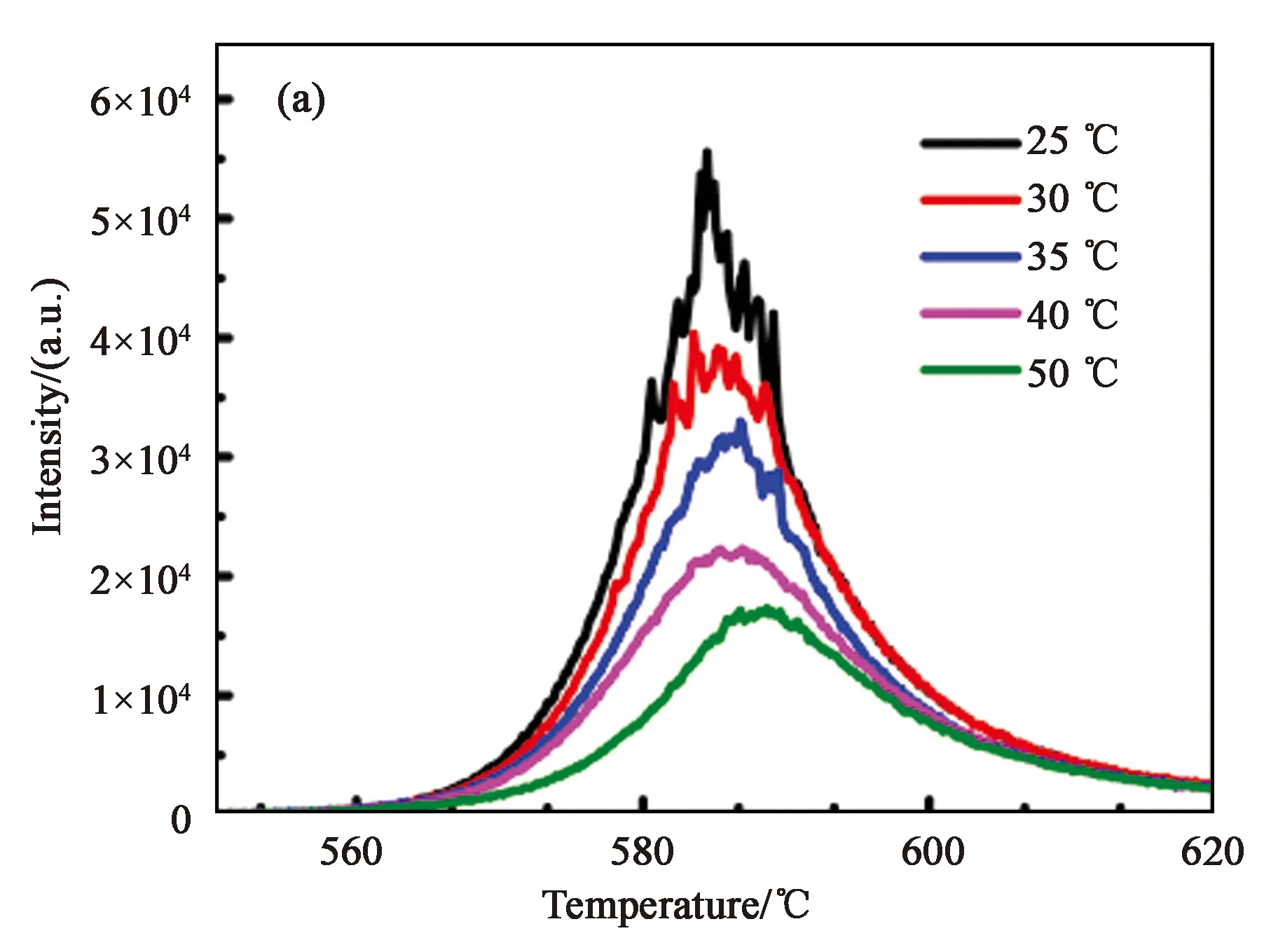
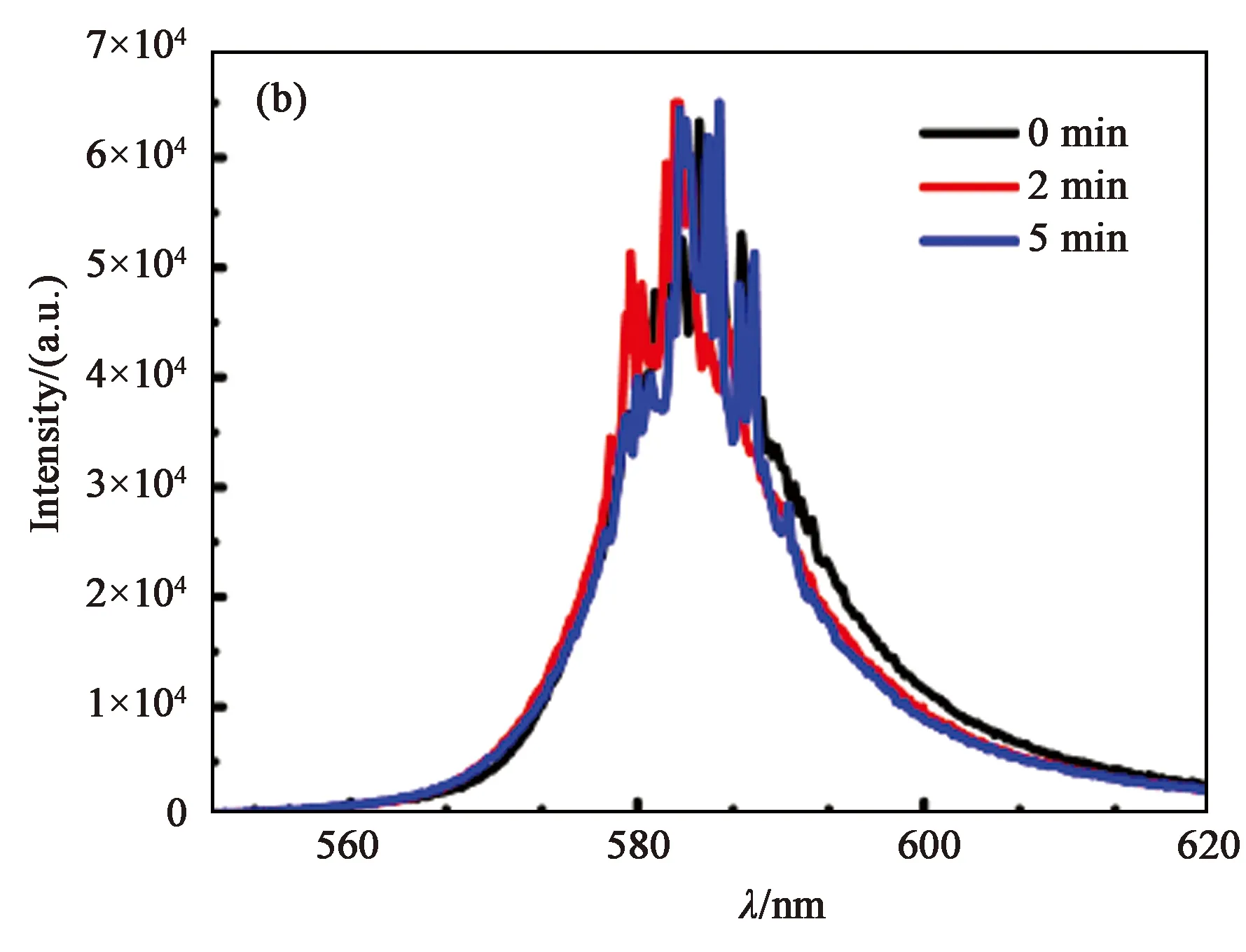
Fig.7 Influence of (a) temperature and (b) pump time on random lasing properties from 300 μm capillary samples at a fixed pump energy of 25 μJ/pulse
4 Conclusions
This paper demonstrated the optically tunable random lasing from azo-dye-doped polymer dispersed liquid crystal in capillary tubes. The azo-dye-doped PDLC was fabricated in capillaries with different core diameters (100 μm, 300 μm, 500 μm), and the lasing thresholds of the samples were measured as 11.8 μJ/pulse, 8.6 μJ/pulse and 13.2 μJ/pulse, respectively. During the optical tuning process, the random lasing intensities can be tuned to decrease gradually as the intensities of UV beam increased from 0 mW/cm2to 150 mW/cm2. The results can be mainly attributed to the refractive index change of PDLC samples, which was induced by the photoisomerization of azo-dye MR. In addition, the different polarized UV beam has the similar tunable effect on the random lasing properties in cylindrical capillaries. Finally, we excluded the thermal effect caused by UV beam and pump laser in the experiment.
